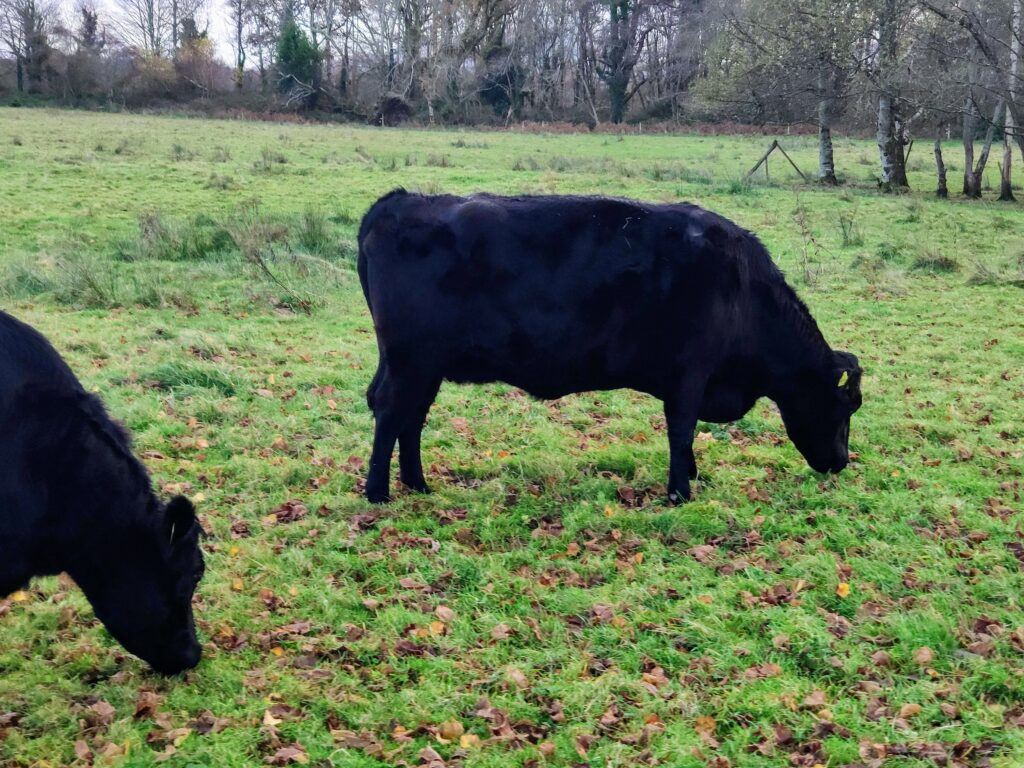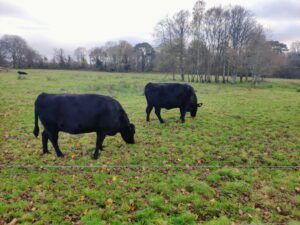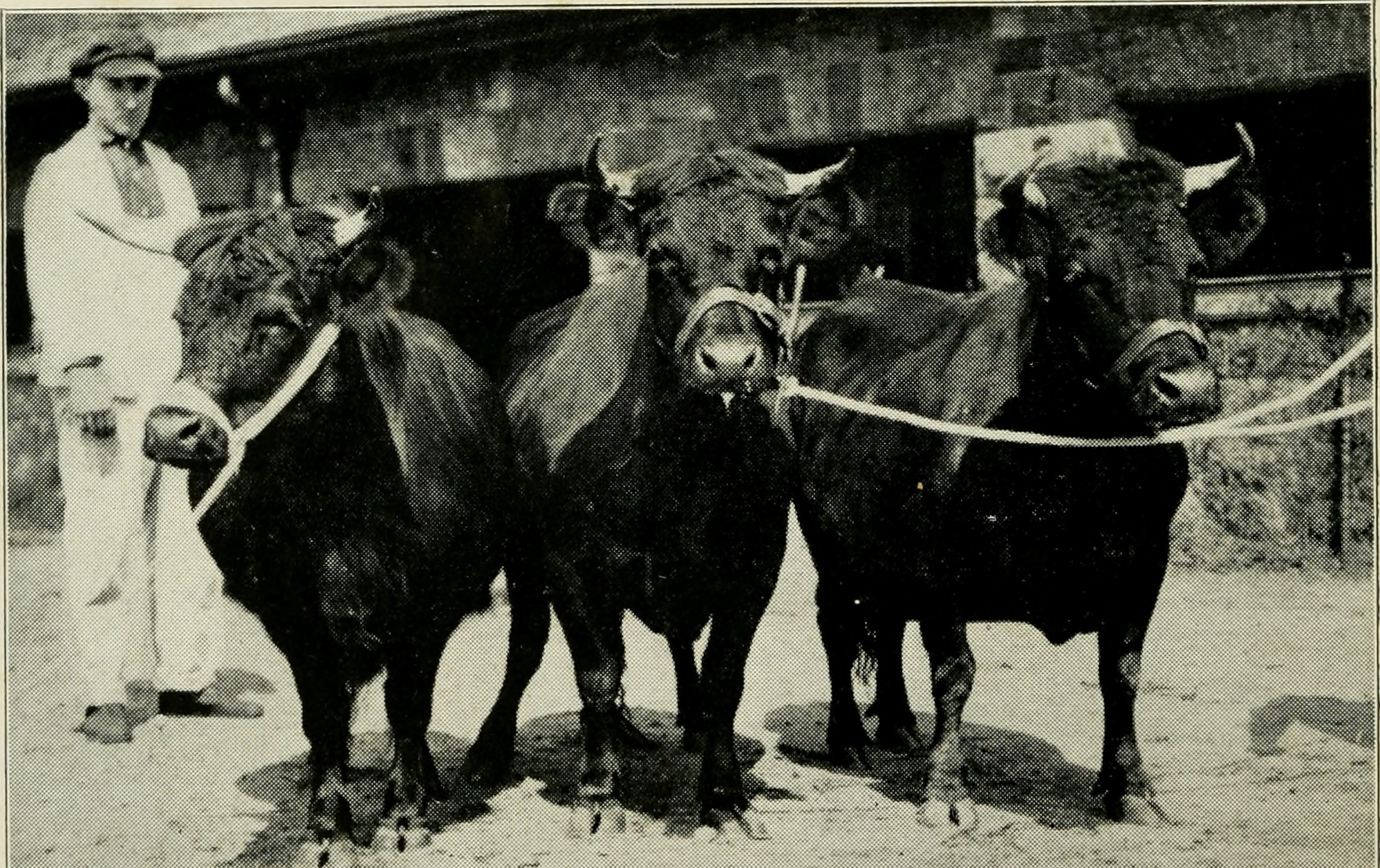There are only four native Irish cattle breeds’ that I am aware of these cattle have been here for hundreds and in some cases maybe thousands of years. It is really only in the last seventy or eighty years that breeds’ from other countries have started to be imported and breed here in large numbers.
The first of these were probably from our nearest neighbors in the UK, breeds’ like the shorthorn came in as dairy cows as they were larger and had more milk than the smaller native Kerry cow. Later in the 1970s the British friesian cows became the new dairy cow which actually originate from friesland in the Netherlands. Holsteins are a dairy breed from north America that had its origins from the Netherlands and Europe but was kept more as an indoor or barn cow in north America.
Beef cattle like the Angus or Polly as it was known here the Hereford and beef shorthorn were the first to appear on our island and later in the 1970s and early eighties breeds’ from France and further afield were imported and breed here. A lot of cattle actually are called after the region that they came from for example Charolais,limousin, aubrac, salers,Hereford are all regions or towns.
So speaking of regions I will start with the first native Irish breed from my own region
the Kerry cow
The Kerry cow is thought to be one of the oldest breeds’ in Europe closely related to the ourochs cattle from the stone age It is also thought to have derived from the Celtic shorthorn and to be brought to Ireland around 2000 BC when man first migrated here from the Mediterranean basin. There is also a story that kerry and dexter cattle are related to the black fighting bulls of spain.

The Kerry was used as a household dairy cow right up to the 1950s and is still considered a good little milker but unfortunately the can’t produce the volumes of milk that a Frisian cow can and their small carcass size (350-400kg) won’t make too much for beef either which is why their numbers have declined so much in popularity and by 1983 their were only around 200 left although their numbers have increased somewhat they are still considered an endangered breed.
As Kerry has the highest rainfall levels Ireland the cows that hail from here are a hardy breed and will thrive on poor quality pasture. They have a hard hoof and will cause less damage to ground than heavier cattle. They grow a thick coat in the winter not to the degree as some Scottish cattle like highlands or Galloway but enough to keep them warm in the Irish climate.
Kerry cattle grow white pointed horns with a darkened tip unless they are debudded as a calf. They are all black in colour although some white markings can appear on the cows udders. Kerry cows used to produce milk almost all year round and as well as supplying milk to the household it was also used to produce butter and cheese. A lot of which was done on the farm using old wooden butter churns turned by hand. 
They average around 3000 to 3500kg of milk per year at around 4% butterfat. It is also claimed that they have much smaller golubles of butterfat than other breeds’ which makes it easier for babies or others who find it hard to take fat to digest. Kerries are said to be a docile but agile breed as one person who owned them told me they are quite enough but would climb trees for something to eat.
I can’t say how good at climbing trees they are but I would think that they are very good grazers even on poor quality ground. There are only a few herds left in the country such as at farmleigh in Dublin and killarney national park in Kerry and a handful kept by farmers around the country. It would be a pity for a cow that has served the Irish people for thousands of years to disappear forever just because they don’t have much commercial value today.
the dexter
The Dexter is closely related to the Kerry deriving from the same black Celtic cattle although it was only in 1845 when a report was written by a Mr David low that we learn how the cattle got its name. Mr Dexter who was agent to a Lord Hawarden (pronounced ‘Harden’) who came to Ireland in 1750 and made his home in Co Tipperary. He started to collect the hardiest mountain cattle in the area to breed which were later exported to the UK and further afield.
The breeds’ ability to thrive in many climates have seen them exported to Australia, New Zealand, Cuba, Argentina, Kenya, Zimbabwe, Italy, Belgium, Denmark and Germany with many Dexter society set up around the world. Like the kerries they are a small breed of around 300-350 kg but are more of a beef breed and many claims they have a unique flavor of beef with some restaurants having a special place on the menu for it.
their are two types of Dexter a long-legged type and a short legged type which has a form of dwarfism and only grow to a shoulder hight of around 3 feet which could make them ideal for pet farms and small areas. Like the kerries they hail from the southwest of Ireland and are usually black but can also come in red or dun. The breed has horns like the Kerry cattle but can also come polled which is a nice option for those who don’t want to be dealing with the horns.

Breeding using a polled bull will be passed down to the offspring. They are an easy calving breed but due to their small size care should be taken to choose an easy calving bull when crossbreeding with larger continental cattle. While Dexter were endangered in the 1970s the numbers have recovered a lot with over 2000 in Ireland alone and many more spread all around the world.
Some people have even bred them into other cattle and by choosing the smallest of their own breed have managed to produce miniature breeds’ of other cows which sell for high prices as pets. This is something I have thought about myself but I am ensure if their is a market here yet for miniature breeds’
I think the Dexter has a lot going for it despite its small size and the fact that it was once known as the poor mans cow. For one thing dispite the fact that it is not much bigger than a sheep it still qualifies as 1 livestock unit they will thrive on poor quality ground stay out longer in bad weather cause less pouching on wet land and eat less feeding over the winter all which could make them highly suitable on peat land or conservation grazing systems in the west of Ireland.
The Droimeann
While only reacently been recognized as a native rare Irish breed after extensive DNA testing many have known that the droimeann was a breed of its own. Due to its looks and size many could be forgiven for mistaking it for a shorthorn in the past. I think too in the past not as much notice was taken of breeds’ in Ireland and a cow was a cow to supply milk and meat
Today their are believed to be 243 breeding females and 23 males, the breed is considered to be at risk. Its designation as a native breed follows extensive DNA profiling that showed its bovine type was distinct from that of other breeds’. They can come in a rage of colours from black, red, blue, or white but the most common is speckled black and white with a white ridge running along their back and a white underside and dark ears and a muzzle.
One droimeann cow known as big Bertha from Kerry was on the Guinness book of records as being the worlds the oldest cow living to just short of her 49th birthday and had 39 calves. Records of the droimeann date back to the Celtic era over 1000 years ago. The 920AD poem ‘Bo Bithbliacht Meic Lonan’ and songs including‘AnDroimFhionn Donn Dilis’ and ‘Ailliu na Gamhna’. The breed originated in the Iveragh Peninsula in Kerry.
They are a mid sized cow bigger than the Dexter and Kerry but still smaller than many continental breeds’. They were kept as a dairy and beef dual-purpose cow but in recent years have been replaced by more commercially bred cows as like the other rare breeds’ they are never going to hold up to a Holstein friesian or a Belgian blue for beef. They are like the other native breeds’ perfectly suited to the Irish climate, and can thrive well on poor grazing ground.
The Irish Moiled

The Irish moiled is the last native breed of cattle on the list and are in some ways similar to the droimeann as they were originally kept as a dairy cow and have a white ridge along their head but the Irish moiled have a distinct domed shaped head which is where they get their name from Moile (or Maol) is derived from the Gaelic language which relates to the dome shape.they are also a naturally polled breed that don’t grow horns.
The Irish moiled usually come in red and white areas along the back and underside with flecked faces and are often called mollies for short. Unlike the other breeds’ that hailed from the southwest of Ireland the Irish moiled originated in the northwest of Ireland mainly Sligo Donegal and Leitrim. While they are still considered a medium-sized cow they are larger than the other native breeds’ with cows growing up to 650 kg. It must be all the good grazing up in the northwest compared to Kerry.
The most cattle derived form Irish moiled are believed to be in Finland as invading vikings were believed to be so impressed by the cattle that they put them on their boats and took them home with them. Because of their larger size and bulls reaching up to 800kg the Irish moiled might be more commercially viable to some people but then again is their any suckler enterprise that is truly commercially viable today without EU payments.
(Click image for price)
Like the other native Irish breeds’ the Irish moiled is said to be a hardy breed capable of thriving on poor quality ground. It is even believed that they are big bellied so they can consume larger quantities of poor quality forage and draw nutrients from it. They are bowsers like highlands and I think like some other native Irish breeds’ too meaning they will graze trees like willow,ivy and ash. They are said to be an easy calving docile breed but as with all cattle never trust a bull or a cow with a young calf.
Although the Irish moiled society was established in 1926 by the 1970s its believed their were only less than 30 females left kept by two breeders in northern Ireland. They have gone from being category 1 critical endangered in the early 2000s to category 4 at risk today so while they are making a recovery they are still a rear breed.
Bo Riabhach
I almost left this one out but thanks to Michael for commenting below I found out about the rarest Irish breed of cattle of all so rear in fact that I never heard of them until today. Only 4 years ago they were on the verge of extinction when it was thought that there were only 30 animals in existence. The name riabhach is translated from Old Irish as brindled, streaked or striped. In fact, Bo Riabhach translates from Irish into English as “The Brindled Cow
They have very unique markings of brindled redish brown and black almost like stripes on a tiger. Calves are often born bright red with a purple crown, tail tip and eyelashes. Some calves are born with the brindle pattern, though this usually starts developing at around four weeks old. It starts developing around the eyes first before the head and face begin to turn darker and brindle patterns begin also showing up on the spine. By 8 months, the brindle pattern should be fully developed.
The exact origins of the cattle are not known but there are records of them in Ireland dating back to the 7th century AD so I think its safe to say that they are surly a native Irish breed.
My own thoughts
Half of the rear Irish breeds’ come from the southwest of Ireland the Kerry, the droimeann, the Dexter and the Kerry bog pony all originating around the Kerry area with the galway sheep the Connemara the Irish draught and the Irish moiled from other parts of Ireland
I think during the early 80s and 90s their was a big swing in Ireland to produce bigger cattle and more kg of meat per carcass. In recent years with the rising cost of living and input costs of ration and fertilizer I wonder if many are actually that better off with large continental breeds’ by the time feeding costs and wintering costs are calculated especially in the western seaboard of Ireland where winters and housing periods can be longer than 6 months
Or are we stuck in a mindset of bygone days to supply the factories with the fittest cattle available even if it is not profitable to do so. Maybe the rare Irish breeds’ that have been here for thousands of years might still have some use here after all particularly in marginal farmland that is never going to compete with the fattening land of the golden vale anyway.
It is up to every farmer to consider what best suits their own system as we all have to make a profit to continue anyway but wouldn’t it be nice to keep our rear Irish cattle breeds’ around for the next generation along with the family farm.
If you have the time have a look at my article about Irelands rarest pony here





13 thoughts on “Irish cattle breeds”
Great article, really enjoyed it……. Look up “Bo Riabhach” cattle some really interesting work being done
Thanks Michael
I had not heard of Bo Riabhach I will add them in every day is a learning day. I also wanted to mention something the man on the video mentioned about the relationship between the Dexter and Kerry with the black bulls of Spain possibly coming from when some of the Spanish armada were shipwrecked off the southwest coast and the cattle swam ashore. It might not be the case but it puts an interesting spin on the little black cattle and their connection with the Spanish bulls.
It would be quite interesting to know where the cattle heads that oscar Wilde studied and wrote his thesis on at trinity college Dublin are stored and located as a wealthy of forensic research and knowledge could be achieved by studying them once again using new methods of DNA methods which would give a good indication of cattle breeds and there welfare in around the time of the famin in the 1800s
I had not heard about Oscar Wilde studying cattle peter but I would agree if it could be possible or maybe even storing DNA and stem cells from endangered breeds of animals now that could be used in the future
great article it helped me learn about the cows so i could make lauren proud of me
Thanks
Hi
Thanks for providing great facts on the highland cattle.
My husband is interested in trialing a couple of highland heifer calves and I’m trying to surprise him with them for his 50th birthday in January. Do you currently have any stock for sale?
Thanks
Hi Paula sorry I don’t have any highlands for sale at the moment they sometimes come up under the cattle section on done deal.ie
the brindle cow or bo riabhach how many are left now and is there a hope they will survive as a separate 4th breed.What counties are they native to and found in’
They are still very rare and like the Kerry would be still at risk. there is an intresting podcast by Ela Mcsweeny here https://www.rte.ie/radio/radioplayer/html5/#/radio1/21797765 which tells there story in more detail.
thanks DJ I also saw snippets of info on Roscommon Sheep,not sure if they’ve survived as a breed though-or maybe a variety of Galway Sheep.
I had not heard of Roscommon sheep but my brother in law kept some galway sheep. animals can crossbreed in history which can lead to different breeds being closely related genetically such as the kerry and dexter even the kerry bog pony and exmoor ponies are a lot alike. I will have to write a bit about sheep now.
I have in calf brindle heifer she was bought of dealer and originated in R of I
Reluctantly I wil be selling her within month